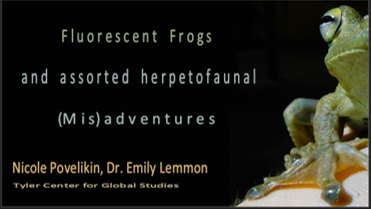President's Showcase
Nicole Povelikin
Supervising Professor: Dr. Emily Lemmon
Nicole Povelikin is a third year Biology major focusing on ecology and evolution, hoping to pursue a career in scientific research at a museum. Her research concentrates on herpetofauna (reptiles and amphibians), but she is more broadly motivated by theoretical questions surrounding adaptation, reticulate evolution, biological invasions, and speciation. Nicole began research in high school at the American Museum of Natural History in New York City, and through the IDEA Grant program, was able to travel to a different natural history collection this summer in Ecuador.
Abstract
Described only six years ago, the ecological function of amphibian biofluorescence remains an enigma. Many hypotheses have been suggested ranging from ‘no function whatsoever’ to ‘communication for mating purposes’, but tests of these hypotheses are still hindered by a lack of data. Plans to collect additional biofluorescence data this summer fell through because of political conflict at the intended field site between indigenous groups and Ecuador's national oil company, so I instead traveled to several other field sites in Ecuador to assist researchers working at PUCE. Using data and photos of frog biofluorescence collected by graduate student Courtney Whitcher last summer, I sought to document the diversity of variation in biofluorescent patterns and unravel the biological significance of this variation. I collected data on the percent of a frog’s dorsal area that biofluoresced, and used data on the intensity of fluorescence to examine the intraspecific variation in these traits among different species of Dendropsophus frogs. I also mapped ancestral character states to understand how these traits have changed over evolutionary time.






